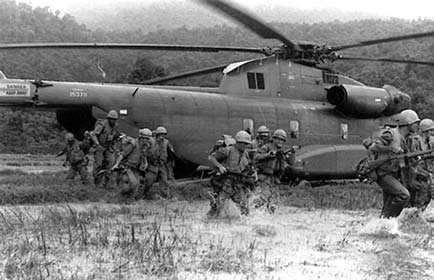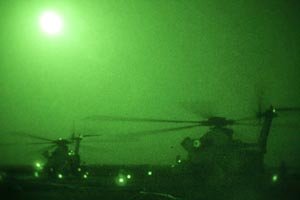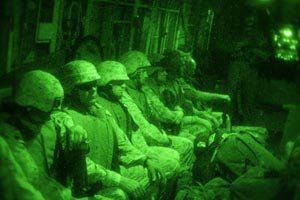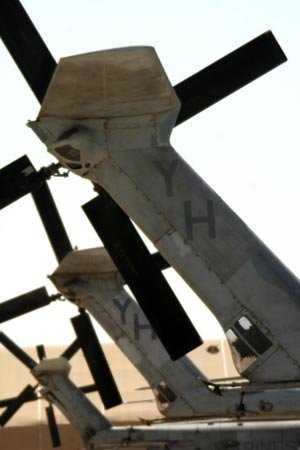« "Hezbollah, Hezbollah," Chanted The Iranian Crowd of Suicide Bombers | Main | Capitol Police Investigating Sounds Of Gunshots »
May 26, 2006
Pegasus Marines Continues With Same Aircraft

Marine grunts exit their transportation, a CH-53A Sea Stallion with Marine Heavy Helicopter Squadron 463, to begin a search and destroy operation 17 miles southeast of Phu Bai, Vietnam, Nov. 18, 1967. Initially a World War II bomber squadron, HMH-463, Marine Aircraft Group 16 (Reinforced), 3rd Marine Aircraft Wing, flew the first CH-53s in Vietnam with the main mission of providing assault support transport, which they still do today. (Photo by: DoD Photo National)
Pegasus' 40-year-old legacy of service continues in Iraq
Submitted by: 3rd Marine Aircraft Wing
Story by Lance Cpl. James B. Hoke
AL ASAD, Iraq (May 25, 2006) -- In December 1966, the first personnel with Marine Heavy Helicopter Squadron 463 touched down in Da Nang, Vietnam, without any aircraft. It wasn't until Jan. 8, 1967, that the ship carrying four CH-53A Sea Stallions arrived for the Marines.
Nearly 40 years later, Pegasus Marines are serving their country in another war under the same aircraft group, Marine Aircraft Group 16, with the same aircraft that were presented to them during the Vietnam War two years after their initial landing -- the CH-53D Sea Stallion.
The squadron was originally a fixed-wing bombing squadron during World War II that has served on each coast of the United States, including Hawaii. Having served in more than nine MAGs and all three Marine Aircraft Wings, the squadron has been deactivated three times before it was finally activated again as HMH-463.
"HMH-463 was the first CH-53 helicopter squadron in the Marine Corps," said Lt. Col. Randel W. Parker, commanding officer, HMH-463, MAG-16 (Reinforced), 3rd MAW. "We have always been an assault support platform since this helicopter was introduced in 1966."
According to retired Marine Col. Charles A. Block, the commanding officer of HMH-463 in 1970, the ground commanders loved to use Pegasus because of the number of Marines the, at the time, new helicopters could carry in one trip.
"We would normally carry around 50 combat Marines," said the 72-year-old veteran who resides in Enterprise, Ala. "With four helicopters, we would put an infantry company on the ground at one time, ready to fight."
Block recalled one night when the squadron helped conduct the largest night tactical assault ever accomplished by Marine Corps aviation.
"We had 15 CH-53s leading about 20 CH-46s with simultaneous landings under flares from a C-47 flare ship," he said. "The troops not on the assault had climbed on top of the hardback parking revetments to watch us return. You have to realize that these same observers were going to be on the flight line at (5 a.m.) and it was about (2 a.m.) when we returned.
"Nobody asked or even suggested that they welcome us back, but they did it on their own," Block added. "I would describe the Marines in this squadron as being the most dedicated, hard-working bunch of folks I have ever seen in my 28 years in the Marine Corps. They broke every record for cargo and troop hauling that had ever been set up to that date."
However, the Pegasus Marines continue to grow and improve on the inheritance set upon them.
"The squadron improves with every new Marine we get," said Parker, a 44-year-old native of Littleton, Colo. "You try to build onto the legacy of the Marines who came before you and improve on that. Hopefully, in a year when people rotate out of here and we get new people in, they'll continue to build upon that.
"The Marines here are highly motivated and dedicated," the graduate of Embry-Riddle Aeronautical University continued. "They understand their mission and do it the best that I've ever seen. It is truly amazing. It is a testament to themselves and their families. Basically, it just shows you what kind of great young Americans we have."
Although the squadron has a fruitful legacy to live up to, it has already begun to set its own records, as it is the first full Delta helicopter squadron to deploy to Iraq in nearly 15 years.
"It's quite an honor to be the first, but our main goal in being the first is to be able to maintain a strong presence and represent the CH-53D community," said Parker. "As soon as we're done with our deployment, (HMH-363) will replace us, which is another CH-53D squadron, and then they'll be replaced by (HMH-362). We kick this off for the community, but it is also our job to sustain operations."
According to Sgt. Maj. Karl Villalino, sergeant major, HMH-463, the squadron's guest speaker before departing their home station at Marine Corps Base Kaneohe Bay, Hawaii, was a retired sergeant major who used to be a crew chief for the squadron during the Vietnam era.
"He gave his lessons that he had learned during that time frame to the Marines who were literally about to leave in three weeks after the ceremony," said Villalino, a 37-year-old native of Long Beach, Calif. "I think it had significance, as the Marines understand that this platform we have and use has done great things before in Vietnam and Desert Storm."
Although the Vietnam era has left its lessons and records with HMH-463, the Pegasus Marines continue to strive for excellence.
"You have a group of Marines who are excited and committed to support operations out here in (Operation Iraqi Freedom)," said Parker. "They have great people, whether it's immediate family, moms and dads or brothers and sisters, back home to support them. They understand that what we are doing is really great for the American people."
"Some people say, 'How can an old aircraft like this continue to do what it's doing?'" he concluded. "My simple response to that is that it says Marines on the side of it, and Marines do great things."

Two CH-53D Sea Stallions with Marine Heavy Helicopter Squadron 463 sit at the hot pits on Al Taqaddum, Iraq, May 18. Initially a World War II bomber squadron, HMH-463, Marine Aircraft Group 16 (Reinforced), 3rd Marine Aircraft Wing, flew the first CH-53s in Vietnam with the main mission of providing assault support transport, which they still do today. (Photo by: Lance Cpl. James B. Hoke)

Marines from various units and squadrons sit idly by during transport from Al Taqaddum, Iraq, to Al Fallujah, Iraq, May 18, on a CH-53D Sea Stallion with Marine Heavy Helicopter Squadron 463. Initially a World War II bomber squadron, HMH-463, Marine Aircraft Group 16 (Reinforced), 3rd Marine Aircraft Wing, flew the first CH-53s in Vietnam with the main mission of providing assault support transport, which they still do today. (Photo by: Lance Cpl. James B. Hoke)

Posted by Wild Thing at May 26, 2006 03:55 AM
